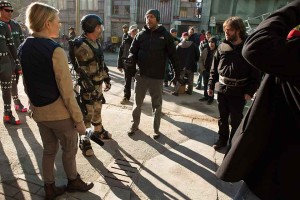
To prepare for the film, Price first reviewed the original three RoboCop movies. “What attracted me to it was that there are a lot of themes in the original movie about corporate position in society and the media’s role in society,” he said. “All of these things in the 1987 version were a little over the top. A lot of the themes have transplanted themselves to everyday life here, in addition to the main question: ‘What does it mean to be a human being?’ We are looking at the way technology is encroaching on our every day life.”
Given the Brazilian-born director’s predilections for a verité feel for this sci-fi/action update, Price went forward with a new plan, atypical for genre films. “Rotoscoping and camera tracking could be used for the intense camera movements that Padilha wanted without going to a greenscreen stage,” Price explained, noting that long takes inhibit some of a visual effects supervisor’s tricks, such as cutting away from live-action moments to visual effects shots. “We knew we couldn’t do those.”
One of the more engaging aspects of Padilha’s approach to the movie was the preponderance of handheld camera work. “We did use steadicam and cranes, but a majority was handheld,” said Price. “That really just meant a lot of extra tracking work for us. Sometimes that would help us, but we did have to tack our camera down and match our CG. There was a lot of spontaneity overall. The camera and actors might not be doing the same thing on every take. We kept it a little loose.”
As for Padilha’s plan for long takes, Price noted that his effects elements in live-action shots – including several types of robot characters – would have to naturally occur within a shot without the benefit of cutaways. “We found ourselves painting things out that transitioned from live-action to CG,” he described. “That was really a lot of the fun. How do we do this effect, knowing that we might only use a small portion of this take? We were proud that we didn’t end up restricting [Padilha], giving him that freedom. It helped keep the movie intimate and the visual effects intimate. Back in the old days, the camera was locked off – cue the visual effect. We have such power now, we are able to let our effects fit in with this style of movie.”
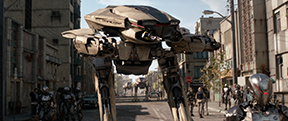 In addition to the RoboCop character himself, another familiar element from the 1987 film was the Enforcement Droid, ED-209, a two-legged combat robot realized in the first film with a combination of full-scale props and stop-motion animation. “We wanted to reflect back upon it and honor it in a way that the fans would feel appropriate, but with motion that is appropriate for today,” Price said. “We had a wire-frame representation that could be pushed around and help the actors with eyelines and camera. We often ran multiple cameras. We wanted each operator to have something to focus on and frame. We pushed it through the scene, painted it out and replaced it with our computer-generated ED-209.”
In addition to the RoboCop character himself, another familiar element from the 1987 film was the Enforcement Droid, ED-209, a two-legged combat robot realized in the first film with a combination of full-scale props and stop-motion animation. “We wanted to reflect back upon it and honor it in a way that the fans would feel appropriate, but with motion that is appropriate for today,” Price said. “We had a wire-frame representation that could be pushed around and help the actors with eyelines and camera. We often ran multiple cameras. We wanted each operator to have something to focus on and frame. We pushed it through the scene, painted it out and replaced it with our computer-generated ED-209.”
In addition to ED-209, the new film features an original creation, the EM-208, a humanoid infantry robot that could perform tasks and interact with people. “It was all digital,” Price revealed. “We had a stationary stand-in that we put on wheels for the performance of the EM-208. We put the stunt people in gray suits with tracking markers.”
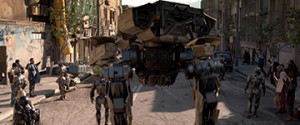 To accomplish the 1070 effects shots required for RoboCop, Price spent 21 months on the show and bid out the work to multiple vendors. “For each of the companies, we found work appropriate for them, and I supervised,” he said. “The visual effects supervisor is often on the show the longest. We go right through the DI so that the color of the visual effects matches the surrounding scenes. There were many different shots – robots, work on Robocop, environment, screen graphics, buildings.”
To accomplish the 1070 effects shots required for RoboCop, Price spent 21 months on the show and bid out the work to multiple vendors. “For each of the companies, we found work appropriate for them, and I supervised,” he said. “The visual effects supervisor is often on the show the longest. We go right through the DI so that the color of the visual effects matches the surrounding scenes. There were many different shots – robots, work on Robocop, environment, screen graphics, buildings.”
As is typical on most large-scale Hollywood films, to effectively organize this massive task, Price and his visual effects producer broke down the script and grouped shots which would be fed out to different effects vendors. “One character has to be done in one place,” he said. “You take advantage and assign the work appropriately. OmniCorp [the main corporation depicted in the film] does prosthetics. We introduce this technology: 40 shots with a guitar player playing with two prosthetic arms. Soho Visual Effects did that scene. The digital arms only appear in that scene. The art department helped design the digital arms. Then we filmed a professional guitar player, painted out his human arms, and replaced them with the digital arms.”
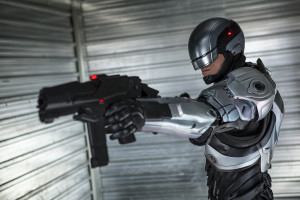 Price described how the effects vendor Framestore created the ED-209 robots seen at the beginning and end of the movie and the EM-208 character. Another standalone was the Novak Element – a futuristic TV show on a large set with 270-degrees of video screen around the on-camera host, shot against a greenscreen. “He is very capable of visualizing things that aren’t there on set,” Price said of Novak actor Samuel L. Jackson. “Those scenes are handled by Method. They also did composites.”
Price described how the effects vendor Framestore created the ED-209 robots seen at the beginning and end of the movie and the EM-208 character. Another standalone was the Novak Element – a futuristic TV show on a large set with 270-degrees of video screen around the on-camera host, shot against a greenscreen. “He is very capable of visualizing things that aren’t there on set,” Price said of Novak actor Samuel L. Jackson. “Those scenes are handled by Method. They also did composites.”
Reflecting on his overall job, Price remarked that in handling outside vendors, he must decide what scenes are standalone and do not necessarily rely on other elements, explaining that this type of film has a duly complex effects palette. “We had a lot of sharing,” he said. “For the digital Robocop suit – we ended up sharing that model, working with visual effects companies all over the globe. Sharing is the reality of it. Particularly with the way that the marketplace has gone global, you do want to play ball and be a part of it. There is a lot more encouragement to share. There is a lot more technology where you can transfer data without sharing your proprietary tools. We had four different vendors working on digital Robocop for different scenes.”
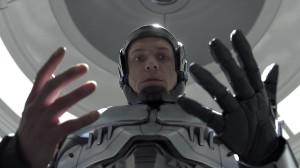 Of course, much of the RoboCop character featured star Joel Kinnaman in a practical suit created by Legacy Effects, but that was only one of many approaches. “RoboCop [himself] was a real spectrum of effects,” said Price. “We wanted a guy in a suit. We knew we could get things in camera. We knew with the suit, we were going to augment him and make him more than just a performer in a suit. We added mechanical joints which were visible. When the performer moved to expose a rubber undersuit, we replaced those pieces to make him look mechanical. We were comfortable handing that work to multiple companies. We had motorcycle riding shots where they had to wear a safety helmet. There were a handful of moments where RoboCop had to do something that a human couldn’t do. We would transfer from Joel’s performance to digital and back. We shared and monitored the work.”
Of course, much of the RoboCop character featured star Joel Kinnaman in a practical suit created by Legacy Effects, but that was only one of many approaches. “RoboCop [himself] was a real spectrum of effects,” said Price. “We wanted a guy in a suit. We knew we could get things in camera. We knew with the suit, we were going to augment him and make him more than just a performer in a suit. We added mechanical joints which were visible. When the performer moved to expose a rubber undersuit, we replaced those pieces to make him look mechanical. We were comfortable handing that work to multiple companies. We had motorcycle riding shots where they had to wear a safety helmet. There were a handful of moments where RoboCop had to do something that a human couldn’t do. We would transfer from Joel’s performance to digital and back. We shared and monitored the work.”
In postproduction, especially on a large visual effects film, Price explained that his daily routine at that stage is about “iterating the shot.” He explained that he begins by giving background “plates” to a specific visual effects company which roughs in their visual effects work. That process goes back-and-forth between effects vendors and editorial and keeps getting honed all throughout postproduction. “Rough blocking puts in a rudimentary effect to make sure that the framing and timing is right,” he stated. “The director will give me notes. When I feel like the shot meets the director’s requirement, it will be cut in and passed along. Effects vendors refine the shot and animation and final composite, and it’s cut in. If it meets the requirements, we screen it a couple times a week. If the director likes it, that shot’s done.”
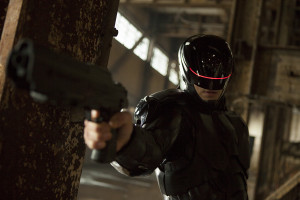 Price feels that his RoboCop effects deliver intimacy. “One of the things that we are really proud of is how well our effects sit in with the rest of the movie,” he related. “Part of what makes this movie work is how the audience relates to this movie. When Robocop is disassembled: it makes you ask the question what it means to be a human. He’s 95% robotic. That’s a very raw and emotional scene. The effects help the audience get intimate with who Alex Murphy really is. Because of José’s style of really having the camera in the middle of the action, we knew that our effects were going to have to be seamless and realistic to keep the audience in the movie.”
Price feels that his RoboCop effects deliver intimacy. “One of the things that we are really proud of is how well our effects sit in with the rest of the movie,” he related. “Part of what makes this movie work is how the audience relates to this movie. When Robocop is disassembled: it makes you ask the question what it means to be a human. He’s 95% robotic. That’s a very raw and emotional scene. The effects help the audience get intimate with who Alex Murphy really is. Because of José’s style of really having the camera in the middle of the action, we knew that our effects were going to have to be seamless and realistic to keep the audience in the movie.”





